Historical Hasselblad Points of Interest for Visitors to Göteborg
By Rick Nordin
If you should ever travel to Göteborg and are interested in Hasselbad history and would like to see some
sites related to the man and his camera, here are some suggestions.
First if you are new to the city you will need a map! Also if you are not European you may find that
driving in the downtown area is confusing and frustrating. Take a taxi, use the excellent Göteborg tram system
– or walk. It is a very nice city to walk around.
It is difficult to recommend where to start, but an important and symbolic point might be the grave of Victor
and Erna Marker 1. They are buried in the church yard of the Örgryte Gamla Kyrka (Old Örgryte Church) off Örgrytevägan
just east of Liseberg and the Svenska Mässan. The grave is most easily found by looking for the distinctive
cast Hasselblad replica on the area on the east side of the church.
The two photos below show a location view
and two views of the grave itself – note it is adjacent to his great grandfather FW Hasselblad. The fallen
leaf (“blad” in Swedish) was on the stone when I took the photo – no placement done!
To the west of Örgryte Gamla Kyrka, make your way to Götaplatsen Marker 2. At Götaplatsen are several important locations.
The Hasselblad gallery (part of the art museum) has continuing exhibits of photography. The
Hasselblad
Foundation has a library and archives which can be visited with prior appointment and is just off Götaplatsen
at Ekmansgatan 8 Marker 3.
Most importantly, a statue of Victor is on the east side of Götaplatsen. It was unveiled on
the occasion of his 100th birthday in 2006.
| The
photo to the right is a view looking north on Kungsportsavenyn from Götaplatsen – with Victor's statue
(photo below) in the centre foreground. | 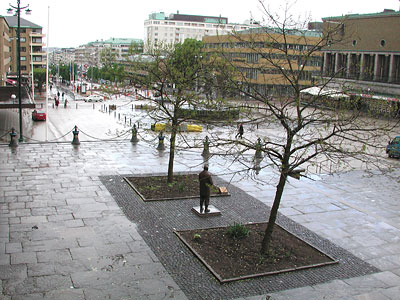 |
 |
|
Traveling north toward the center of the city on Kungsportsavenyn (“the Avenyn”) - the main thoroughfare
of central Göteborg - you will arrive at Kungsportsplatsen on the north side of the canal (Rosenlundskanalen) where the most
notable landmarks are the Tourist Bureau, the major tram station and a favorite local rendezvous spot – a
large statue of a mounted King Karl X Marker 4 – but locally called “the copper horse”.
Kungsportsplatsen is the
location of the original Victor Foto shop that Victor founded in 1937 – his first business enterprise. This
is where everything really began.
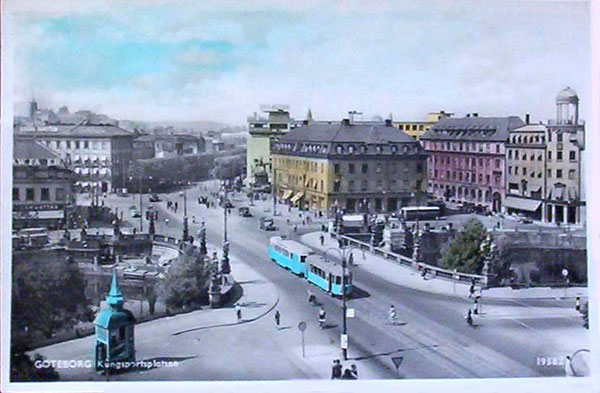 |
| Above an old post card
(from the 1930’s? – to give you an idea of what it was like when his shop was there) and to the right
a photo of the Karl X statue in Kungsportsplatsen.
| 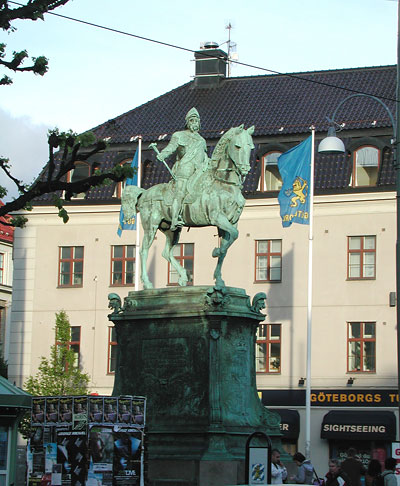 |
Kungsportsavenyn and Kungsportsplatsen become Östra Hamngatan as you travel north. Stop at the building at
41-43 on the west side of the street Marker 5.
The first photo is from the 1950’s the second is from 2006. This building was for many
years the headquarters of Hasselblads Fotografiska – the subsidiary of FW Hasselblad that was the distributor
of Kodak film and the head office of the Hasselblad Foto chain of photo stores owned by Victor Hasselblad from
1942 until it was sold to Kodak in 1966. Hasselblads Foto stores existed to the 1990’s – I purchased a number
of Hasselblad items there and made a point of keeping one of the poly shopping bags that my purchases were
given to me in.
The Factory Locations
Turning right off Östra Hamngatan at Brunnsparken travel along the north side of the canal (Stora Hamnkanalen)
towards Odinsgatan and Odinsplatsen Marker 6 – less than a kilometer. Although it is called Odinsplatsen there is little
evidence of a city square as it has been filled in with buildings.
In Odinsplatsen, we come to the site of
the original Hasselblad factory (where the first Hasselblad cameras were assembled). The original building was
located on Odinsgatan from 1948 to 1951. The original building no longer exists, there is presently a large
building (primary occupant seems to be Securitas) built in the 1950’s or 60’s on the site.
| Odinsplatsen | 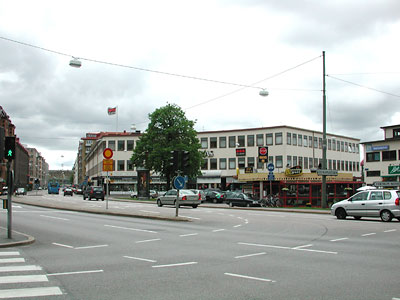 |
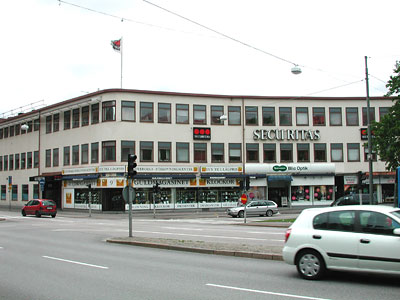 |
|
In late 1951 the operations of camera manufacturing and assembly of cameras was moved to Östra Hamngatan 2 Marker 7,
where it remained until late 2002. This is what I, and many others, refer to as the “old” factory. This was
the building that was built by Victor Hasselblad’s great grandfather to house the FW Hasselblad wholesale
company and the original part dates from the mid 1800’s. This is the building that is most often shown in
postcards and ads from the 1950’s through the 1990’s.
The Östra Hamngatan building with the distinctive
circular corner tower is at the corner of Östra Hamngatan and Sankt Eriksgaten near the river and across from
the new Göteborg Opera House in the area known as Lilla Bommen. The nearest well known landmark is the
Nordstan shopping Center which is on the east side of Östra Hamngatan across the street.
In 1952 an addition
was made to the original building (along Sankt Eriksgaten) and in the 1960’s another addition was made in the
same direction to supply space for the growing company. The styles of these additions is obviously quite
different and reflects the architecture of the times.
The upper floor of the original building was Victor’s
apartment where he stayed when it was necessary to be in the city during the week or when he did not feel like
driving to his country home Råö south of Göteborg.
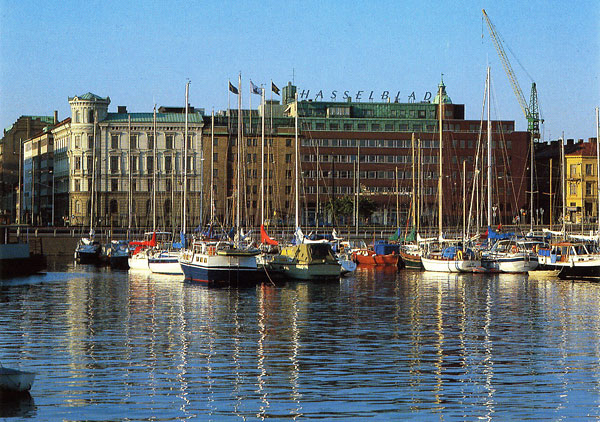 |
| Östra Hamngatan | 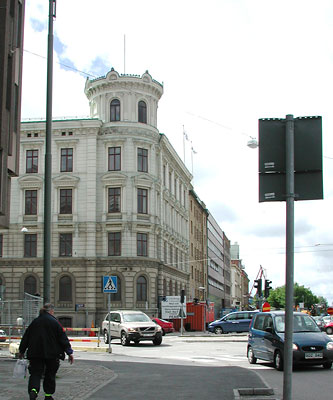 |
|
The Östra Hamngatan building was a charming maze of offices and machine shops and assembly stations, full
of passageways and elevators and totally disorienting to a visitor. However it had wonderful architectural
details and a sense of history. Victor Hasselblad’s apartment on the top floor, which he furnished with
antiques and art was an impressive and exclusive part of the building. Long after he had left it (in the
1990’s when I visited) the area (then used for archiving old files and record books) was still referred to as
“Victor’s apartment”.
In 2006 when I last saw the building it was being developed into condominiums and was being gutted for the
most part. The significant and distinctive oldest part of the building is a designated heritage site and its
style and details are being preserved. An ad in the Göteborg newspaper from May 2006 is shown below. Victor’s
top floor penthouse will have a price of 20 million SEK or about 2 million euros.
 |
In October through December 2002, the factory was moved to a spectacular new custom designed building across
the river at the address Pumpgatan 2 Marker 8. The timing for the move was poor as sales were in a major decline due to
the changes happening in the photo industry – especially the change from film to digital. The building was
designed to accommodate 400 but in the downsizing efforts to save the company, staff was reduced to 75 and
the building was far too big and expensive for this much smaller company in a major financial crisis.
The
Pumpgaten building was innovative but very impractical. It was poorly set up for the purpose of building
cameras, was in an isolated industrial area and generally disliked by the staff who worked there. The
Pumpgaten building has been compared to a huge glass ship on the shore of the Göta Älv. It was felt by many
workers to have been beautiful but not very comfortable or practical. With its extensive glass it was warm and
so bright that reading computer screens was very difficult in most areas. I had the pleasure of visiting the
Östra Hamngaten building several times between 1990 and 2000 and the Pumpgatan building the week after it was
officially opened by the King of Sweden in October 2003.
| Pumpgatan | 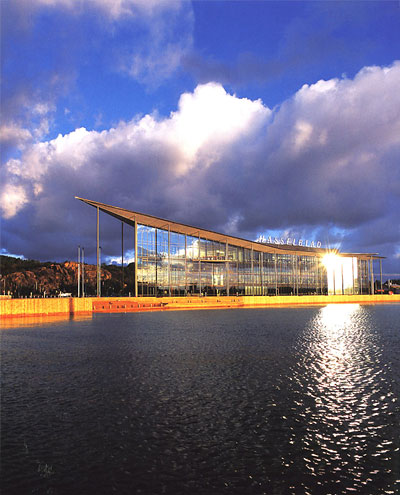 |
|
In 2005 the company moved to an area to the west of the Pumpgatan building to a building in an area known
as Lindholmen where the major presence is Chalmers Technical University. The company occupies the third floor
of a building at Utvecklingsgatan 2. The building exterior is quite nondescript industrial design but the
interior is well designed and comfortable with attention to typical Swedish interior design and ergonomics.
In July 2007 it was announced that Swedish Television, Swedish Radio and the Swedish Educational
Broadcasting Company will be moving into the former Hasselblad building at Pumpgatan.
The glass part of the building, which was used by Hasselblad as both office space and manufacturing area, will house
offices and studios. The lower part of the building, used by Hasselblad as manufacturing area and warehouse,
will be used to accommodate television and radio studios.
The original design by Krook & Tjäder Architects had the building some 14 meters longer along the quay.
This extra space the original design would have provided is now needed again to meet the requirements of Swedish
Radio, and Stefan Tjäder is asked to stretch the building accordingly.
The building formerly known as "Hasselbladshuset" will change its name to "Kanalhuset" - both "Channel House"
and "Canal House".
[Editor]
The Utvecklinggatan building is a much more modest building than the Pumpgatan one and seems to suit the
company in its present stage and size. At its largest in the 1980’s, Hasselblad AB employed more than 500
staff. The present company comprises about 60 employees. If you phone in advance, in most cases you can
arrange an informal tour of the factory.
| Utvecklingsgatan | 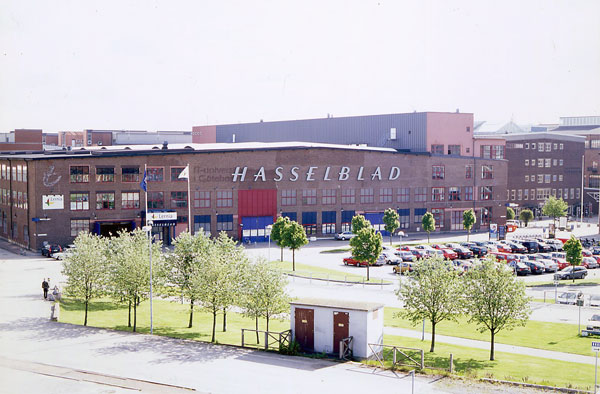 |
|
Copyright 2006 - Rick Nordin. All rights reserved.
All material on this site is protected by law. Unauthorized use is prohibited.
- Hasselblad Historical -